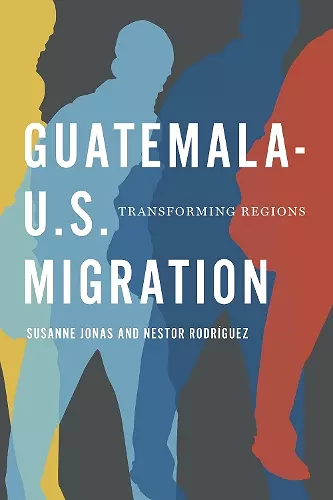Guatemala-U.S. Migration
Transforming Regions
Susanne Jonas author Nestor Rodríguez author
Format:Paperback
Publisher:University of Texas Press
Published:5th Jan '15
Currently unavailable, and unfortunately no date known when it will be back

"Without sounding too effusive, this book is something of a 'tour de force.' While there are books and other studies about Guatemalan immigrant communities, this book is a nice combination of theory, case study, and history. I know of no other book on Guatemala or indeed about other countries that accomplishes this. The writing is superb; the book is very readable." -- Allan Burns, Professor Emeritus, University of Florida, and author of Maya in Exile: Guatemalans in Florida "In this in-depth, meticulous examination, Jonas and Rodriguez combine historical information, rich data, and theoretical arguments to present an impressive, nuanced overview of Guatemalan migration to the United States. Its relevance goes beyond this case, however, as it offers stimulating insights into the meanings of space and place in the study of migratory flows. It is a great contribution to the immigration scholarship, and I highly recommend it." -- Cecilia Menjivar, Cowden Distinguished Professor, Arizona State University, and author of Enduring Violence: Ladina Women's Lives in Guatemala "Susanne Jonas' and Nestor Rodriguez' book is a major contribution to understand the recent history and contemporary features of Guatemalan and, in general, Central American migrations to the United States. In my opinion, one of its outstanding merits lies in their highlighting the regional dimension of migration dynamics. They underline the evolution of this migration region, which is embedded in a host of unfavorable circumstances and perils, as well as the ongoing difficult development of migrants' agency to fight for their rights, goals, and legitimate demands for better living conditions." -- Manuel Angel Castillo, Director of Demographic and Urban Studies, and Professor-Researcher, El Colegio de Mexico "Guatemala-U.S. Migration is an essential book for understanding the dynamics of Guatemalan migration to the United States over the past four decades. Jonas and Rodriguez not only examine the root causes of migration-political repression, social exclusion, and poverty in Guatemala-but also illustrate how global developments and socioeconomic trends in the United States shaped its changing policies towards the arriving migrants. Undoubtedly, one of the book's most invaluable contributions is to demonstrate, in heretofore unavailable detail, the central role that civil society actors, informal and formal organizations and networks, in Central America, Mexico, and the United States have played in advocating for and vindicating migrants' rights and influencing policies throughout the region. This is a book for scholars, legal practitioners, and activists alike, who will benefit from its broad and deep examination of the issues. " -- Karen Musalo, Director of Center for Gender and Refugee Studies and Professor, University of California Hastings College of the Law
This comprehensive study of five phases of Guatemalan migration—both Maya and ladino—to the United States from the late 1970s to the present illuminates the transregional experiences of those who pass through Mexico.
Guatemala-U.S. Migration: Transforming Regions is a pioneering, comprehensive, and multifaceted study of Guatemalan migration to the United States from the late 1970s to the present. It analyzes this migration in a regional context including Guatemala, Mexico, and the United States. This book illuminates the perilous passage through Mexico for Guatemalan migrants, as well as their settlement in various U.S. venues. Moreover, it builds on existing theoretical frameworks and breaks new ground by analyzing the construction and transformations of this migration region and transregional dimensions of migration.
Seamlessly blending multiple sociological perspectives, this book addresses the experiences of both Maya and ladino Guatemalan migrants, incorporating gendered as well as ethnic and class dimensions of migration. It spans the most violent years of the civil war and the postwar years in Guatemala, hence including both refugees and labor migrants. The demographic chapter delineates five phases of Guatemalan migration to the United States since the late 1970s, with immigrants experiencing both inclusion and exclusion very dramatically during the most recent phase, in the early twenty-first century. This book also features an innovative study of Guatemalan migrant rights organizing in the United States and transregionally in Guatemala/Central America and Mexico. The two contrasting in-depth case studies of Guatemalan communities in Houston and San Francisco elaborate in vibrant detail the everyday experiences and evolving stories of the immigrants’ lives.
"…an extremely timely, ground-breaking, and very well written account…of Guatemalan migration to the US…The authors take us far beyond the latest headlines in the first book-length study addressing Guatemalan migration to the US as a national, rather than community-specific, phenomenon. . . Migrants exercise agency in important ways, from deciding to migrate out of desperate conditions to building better living and working conditions in the US to clamoring to change migration policies to practicing cultural expressions and creating organizations in new communities. This in turn has affected the social structure in ways large and small as the larger immigration process reshapes communities across the US. Jonas and Rodríguez have made an outstanding scholarly contribution to our understanding of these issues in a book that deserves a wide readership and discussion." * NACLA *
ISBN: 9780292768260
Dimensions: 229mm x 152mm x 36mm
Weight: 594g
310 pages